This season I’ll be saying goodbye to my sixth garden and beginning planning for spring right now. I’m already collecting seeds for next season and determining what seeds I’ll need to order. Each year I always like to change up my tomatoes and I thought I would share with you come of my tricks and tips for growing tomatoes from seeds.
Here’s a few tips I’ve found over the years growing tomatoes from seeds…
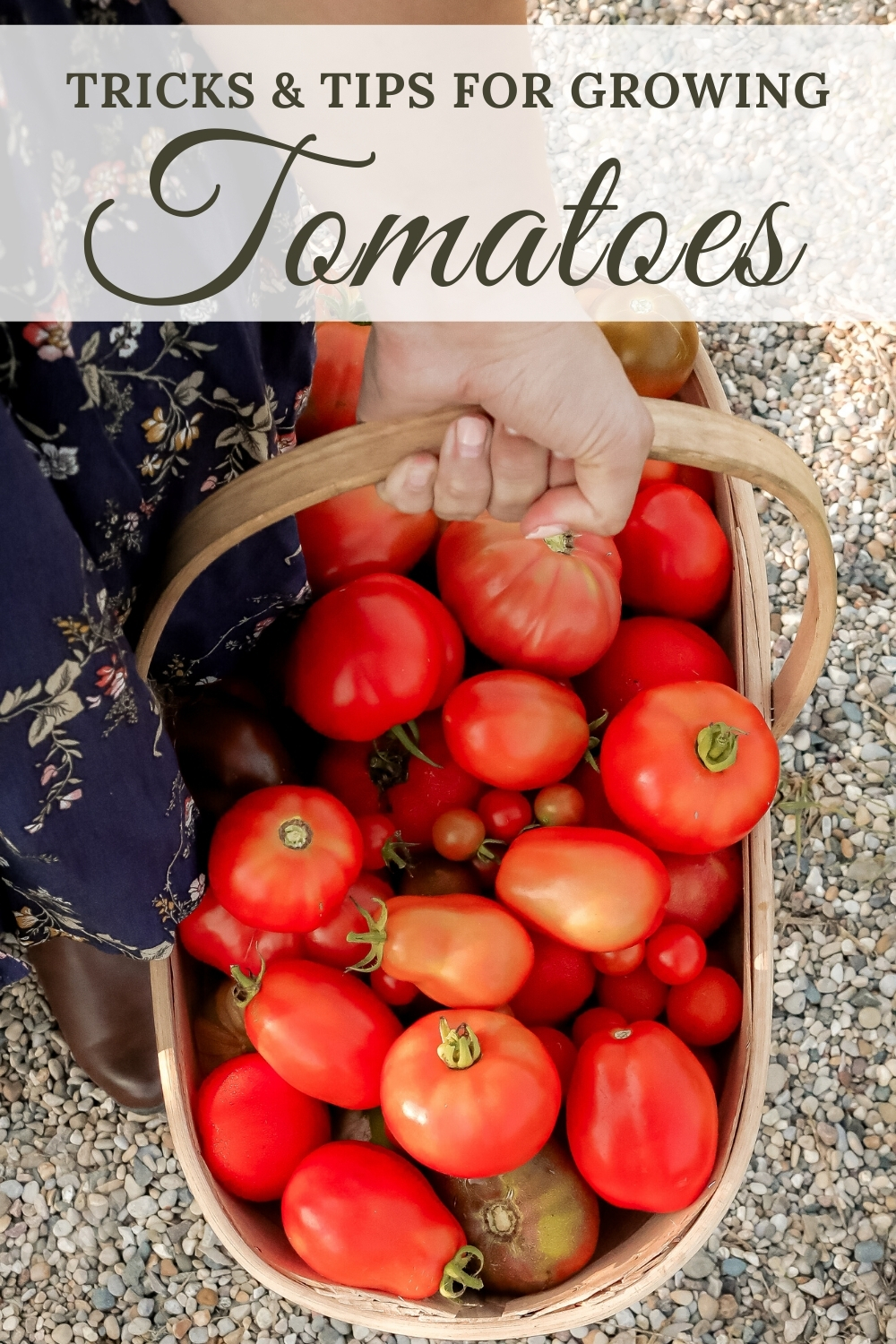
Beginning with growing tomatoes from seeds
Tomatoes are one of the easiest plants to grow. Growing tomatoes from seeds can be simple enough to do as long as you have good starter soil. Basically, you want to find the best soil for growing tomatoes from seeds because you want to give the plant the best start in life. Just like a child, growing tomatoes from seeds requires nutrients and a nurturing hand right from the start so the plant can sprout and develop.
It can sometimes be difficult to find different soils here, so I almost always have to order them online when I’m growing tomatoes from seeds. I always start seeds in this mix {HERE}, but I’ve also used just simple Miracle Gro organic {HERE} too.
My one major requirement is that the soil must be organic when growing tomatoes from seeds – or any vegetable really. We grow everything organically here and don’t like to use anything that isn’t approved for organic use.
Some gardeners and bloggers will tell you that it’s best to “make” your own soil. And while I have no doubt that’s wonderful, I’ve never done it. I’ve had just as much luck with growing tomatoes from seeds using these soils. If you’ve never gardened before, don’t let the community intimidate you. Remember, gardening is about growing and that includes growing your knowledge from year to year.
Growing tomatoes from seeds inside in early spring
If you live in colder climate, like we do in Michigan. You probably need to start growing your tomatoes from seeds inside. Tomato seeds need warmth, light and moist soil to grow. You can have all these things just by placing seedling by a window free of drafts. Our very first garden we grew in a small kitchen window. It was fun because it was easy for us (at the time just my daughter and I) to watch their growth every single day and keep an eye on our plants.
Today, we have a greenhouse on the farm. We used it for the first time this past season growing tomatoes from seeds. It was honestly a learning process for me because I had to deal with more temperature fluctuations than ever before.
Full disclosure: I found growing in the kitchen much easier but I no longer have the room for everything we need to grow.
Previously, I’ve also been growing tomatoes from seeds in the basement! If you are going to grow in a basement or in some place like your garage – also an excellent option – you’re going to need a few things.
In fact, I used these things in the greenhouse and they are helpful whenever and where ever you might be growing tomatoes from seeds. My favorite growing tools include:
- Grow lights {HERE} and these ones {HERE} that I’ve hung from a clothing rod.
- Seed mats {HERE}
- Seedling trays {HERE} – I do not generally use the seed cells in this kit. I prefer to plant in larger, recycled pots and put them in here. I have planted in peat pots previously. You can find those {HERE}.
- Seed starting pellets {HERE} – Although I only recommend using these if you are going to be planting them in the ground almost as soon as they sprout or if you want to replant them. These don’t leave a lot of grow room.
Growing tomatoes from seeds requires it to be at least 65 degrees for the seeds to germinate. So, if you are growing in a place like the garage or basement, you will need some of the items mentioned above. The seed mats are especially helpful with germinations when growing tomatoes from seeds.
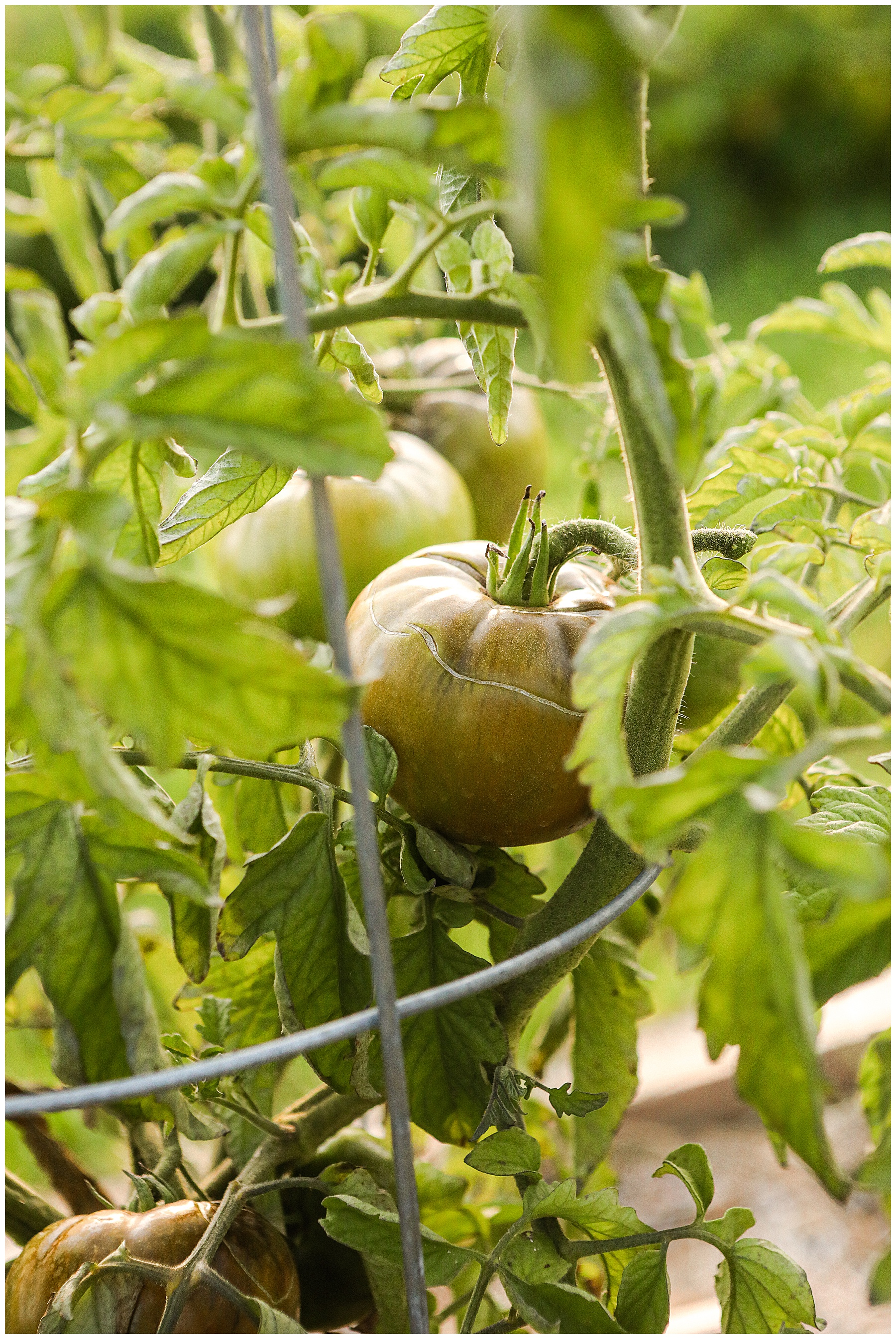
Hardening off tomatoes
If you do start growing tomatoes from seeds inside, then you will need to go through a process of hardening them off before fully moving them outside. This means that as the days warm, you begin to move the seeds outside for a while where they will be exposed to the sun and wind. This helps to strengthen the seedlings. They will grow sturdier if they are tossed around by the wind a bit.
The first day you might move them for two hours, the next day half a day, the next day ¾ of a day and finally a full day.
Some people say it’s best to harden off for a week or more, but I don’t have the patience for that. In fact, I don’t think I’ve ever gone more than 4 days when hardening off my vegetables.
However, the most important thing is to pay attention to the weather during this process. Tomatoes grow best between 55 and 85 degrees, and when growing tomatoes from seeds they require. If the temperature slips to 40 degree or below (or even sometimes 45 degrees) your tomatoes will deteriorate and possibly die. Always move them inside or cover them if they are already in the ground if temperatures fall here.
If the tomatoes are in the ground and still small, I like these plant covers {HERE}.
The best soil for growing tomatoes
Tomatoes thrive in fertile, well-drained soil that is high in organic matter. Each year we build our beds with organic compost or a product called Dairy Doo (This is basically composted cow manure.). Tomatoes get their flavor from the soil so it is important that there is plenty of organic material for them to feast on.
Tomatoes prefer a pH of around 6.0 to 6.8. pH is a measure of the soil acidity. The pH scale goes from 0 to 14 so you can see how tomatoes fall in the middle of that range and prefer a neutral. A pH of 6.5 is about right for most gardens when it comes to growing plants or vegetables. This is also why it’s important to start with a good seed starter soil with growing tomatoes from seeds.
The only out layers are really blueberries and azaleas (and sometimes other fruit trees) that prefer acidic soil.
Tips for transplanting and growing tomatoes
When you’re ready to plant the tomatoes outdoors, plant on a cool, overcast day and plant them deeper than they were in their indoor pots. You can even pull off the bottom set or two of leaves and plant to there, especially if your plants have gotten very tall. If the pants are still short, leave all the leaves on the plants to help them gather nutrients.
Tomatoes are sun worshiper so make sure you pick a place for them that will get at least 8 hours of sun a day. They will give you plenty of fruit if you give them plenty of sun.
Make sure to give your plants plenty of room. While they might start off small since you’re growing tomatoes from seeds, they won’t stay that way. General spacing requirements are to put plants 18-24 inches apart. However, a lot depends on the type and variety you’re growing.
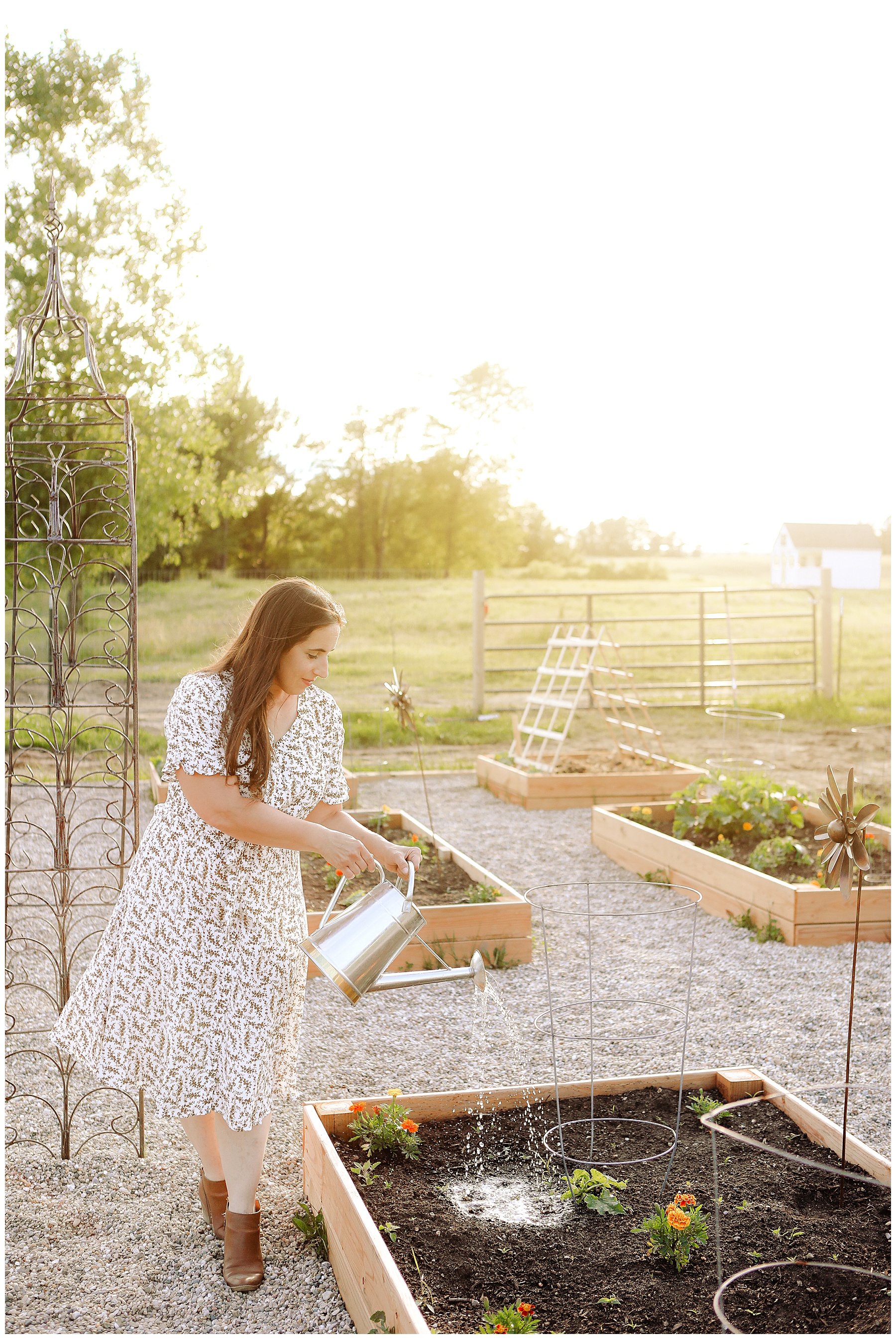
Tips for growing through the season
Also, as they grow, they will either need a tomato cage, trellis or a pole to provide support. The plants get really heavy as the fruit grows and it will weigh down the branches. I’ve always used a cage. I find them easiest and some tomatoes – like Roma tomatoes – are true bush plants and they will grow out no matter how you try to train them. However, I know plenty of people who love growing them up a pole too.
Tomatoes generally need at least one inch of water per week. They prefer to be watered from the bottom of the plant and deeply. Their roots really need to be able to reach to grow correctly. Watering straight from the roots also helps to deter pests and disease, and it prevents premature evaporation from the sun in the heat of the day.
Once your tomato plants are 12-18 inches tall, you might notice some yellowing on the lower leaves. You should remove any of the leaves that are yellowing or any leaves you notice disease on like brown spot. This will help to keep disease from spreading and it will help the plant to continue to give its energy to the healthy portion of the plant.
As the season gets later and the tomato plants go a little wild from the summer heat, I like to thin them out. I’ll remove not only yellow and diseased leaves, but I’ll also remove whole branches that aren’t producing or a lot of leaves in the middle so that the plant can get better air flow. Better airflow helps to keep down diseases, and a lighter plant is easier to spot pests on.
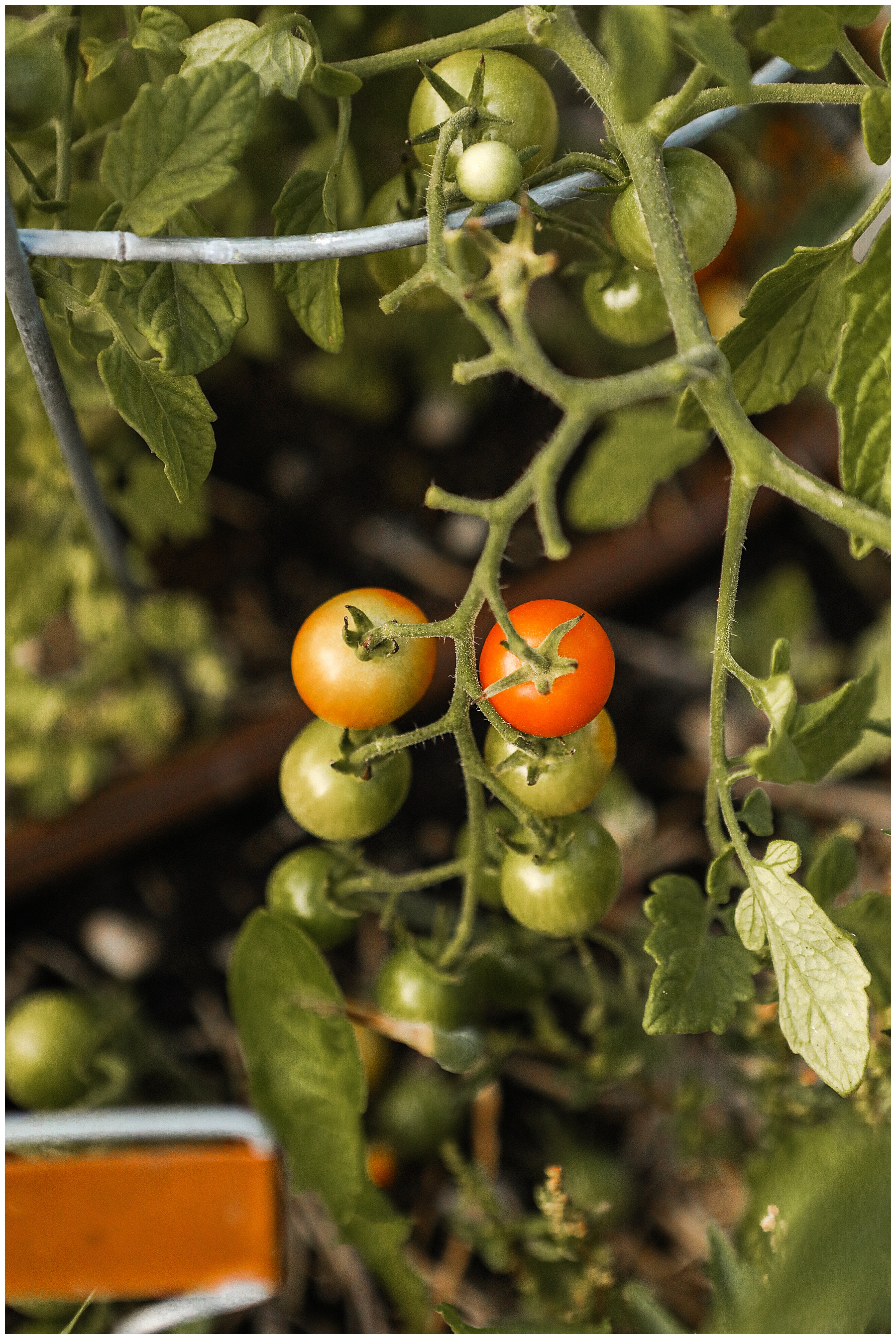
Dealing with tomato pests
The biggest issue people run into when growing tomatoes is the Tomato Hornworm or the Tobacco Hornworm. These are technically two different pests but they look very similar and they will do a lot of damage to your tomatoes if they’re not dealt with. Basically, they will eat everything and you will get nothing.
I battled these in my second garden ever and was able to take care of them by removing them from my plants. However, I only had three or four tomato plants that the time in my suburban garden. Our first year here at the farm, we were overwhelmed by them. There was no way we could keep up with how many plants we had and the pace at which the worms were eating through them.
However, I finally found something that has worked for us. It’s called BT, which stands for Bacillus thuringiensis. It is allowed in organic farming because it is a natural, non-pathogenic bacterium that is found naturally in soil. It is safe for animals and humans. However, it is toxic to caterpillars when ingested. I use it on my tomatoes but also on my cabbages, other lettuces and broccoli too.
BT does not impact earthworms and it is said to not harm bees. However, I do tend to use it in the evenings when all the bees have gone in for the night – just in case. It may impact lady bugs and other beneficial beetles when they are in their larva stage.
I order a couple containers of this BT solution {HERE} each spring. You will need to dilute this so I also use {THIS} sprayer. I realize that sprayer might be a little intense for people with small gardens so I also recommend this smaller unit that we use for vinegar solutions and other natural remedies {HERE}.
For those of you that don’t want to use anything on your tomatoes at all. Your only option is to pick these suckers off your plants and move them to a sacrifice plant or destroy them. They can be hard to spot but they glow under a black light at night so that’s the best time for picking.
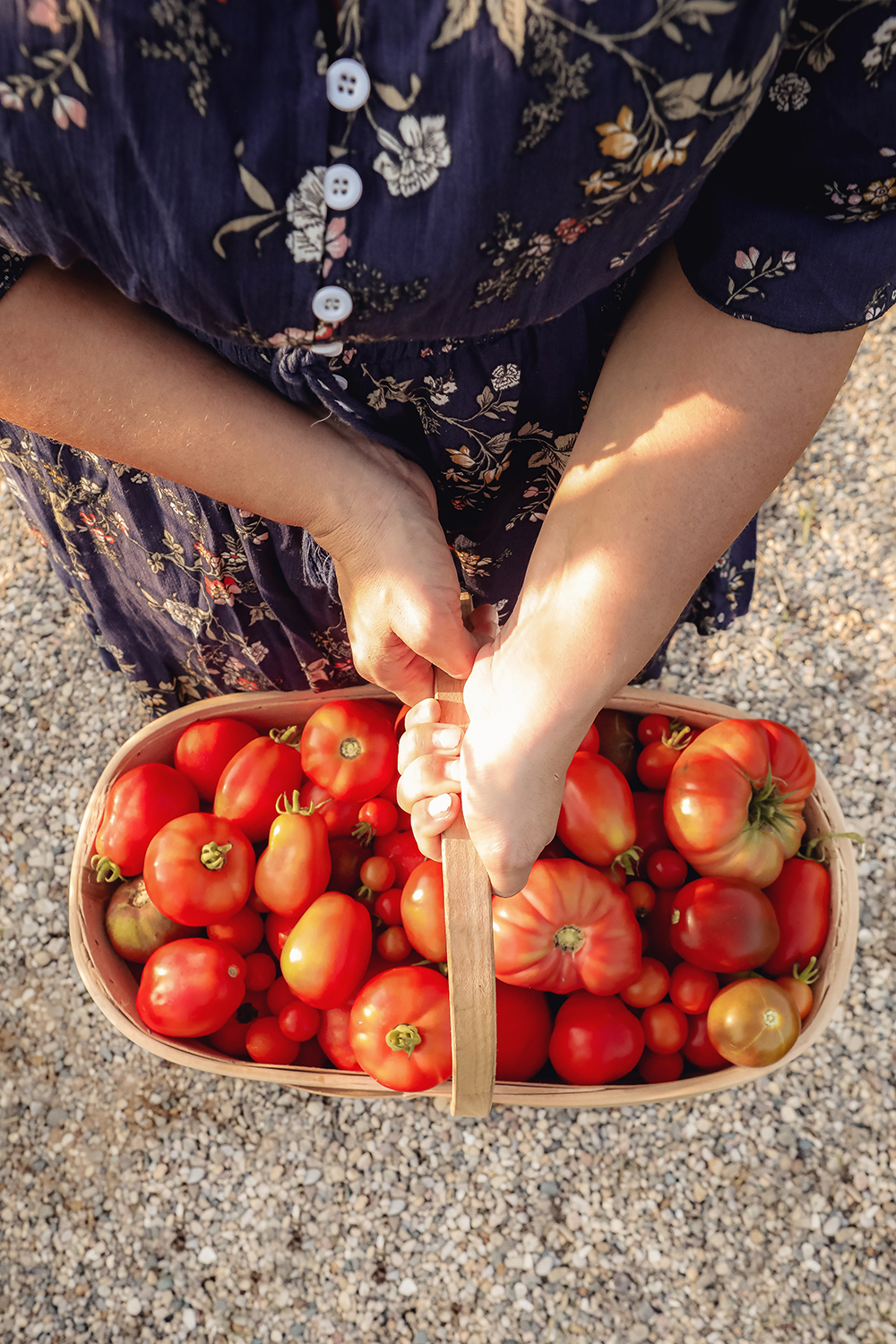
Companion planting for tomatoes
If you’ve started growing tomatoes from seeds then you’ve also probably started growing a few other vegetables and maybe some herbs too. Tomatoes have some friends in the world of gardening and those friends will not only help them grow but also help to enhance their flavor.
Basil and tomatoes are kind of soul mates in the garden and in the kitchen. They thrive off one another and grow really well together. Parsley also grows really well with tomatoes.
Here’s a full list:
- Basil
- Parsley
- Beans
- Carrots
- Onions
- Marigolds
- Celery
- Borage
- Peppers
- Eggplant
- Garlic
- Borage
- Nasturtium
Do not plant these with tomatoes
- Cabbage
- Broccoli
- Fennel
- Corn
For a list of all the best herbs and flower companion plants to help keep insects away, click {HERE}
When to harvest tomatoes
Harvesting tomatoes is simple and it is easy to know when it’s time. They literally change colors for you.
Watch the bottom of the fruit and when it begins to change color, you can begin your harvest. They ripen faster on the vine; however, once you notice a tomato starts ripening all the other creatures of the world will notice too. It makes them more susceptible to damage from animals and insects.
Also, once the tomato begins to turn from green to slightly pin, it will stop taking nutrients from the plant. Leaving it on the vine can slow production and the ripening for additional tomatoes. If too many tomatoes are present on the vine, the plant my experience “fruit overload” and it could impact the production of new blooms.
Thank you so much for visiting today, friends! I hope you found this informative and that it inspires you to garden more. Happy growing! For more tips and inspiration from our garden, visit our garden posts {HERE}. Also if you’re looking for a delicious recipe to try with all your ripe tomatoes, check out the Caramelized Onion and Tomato Tart {HERE}.
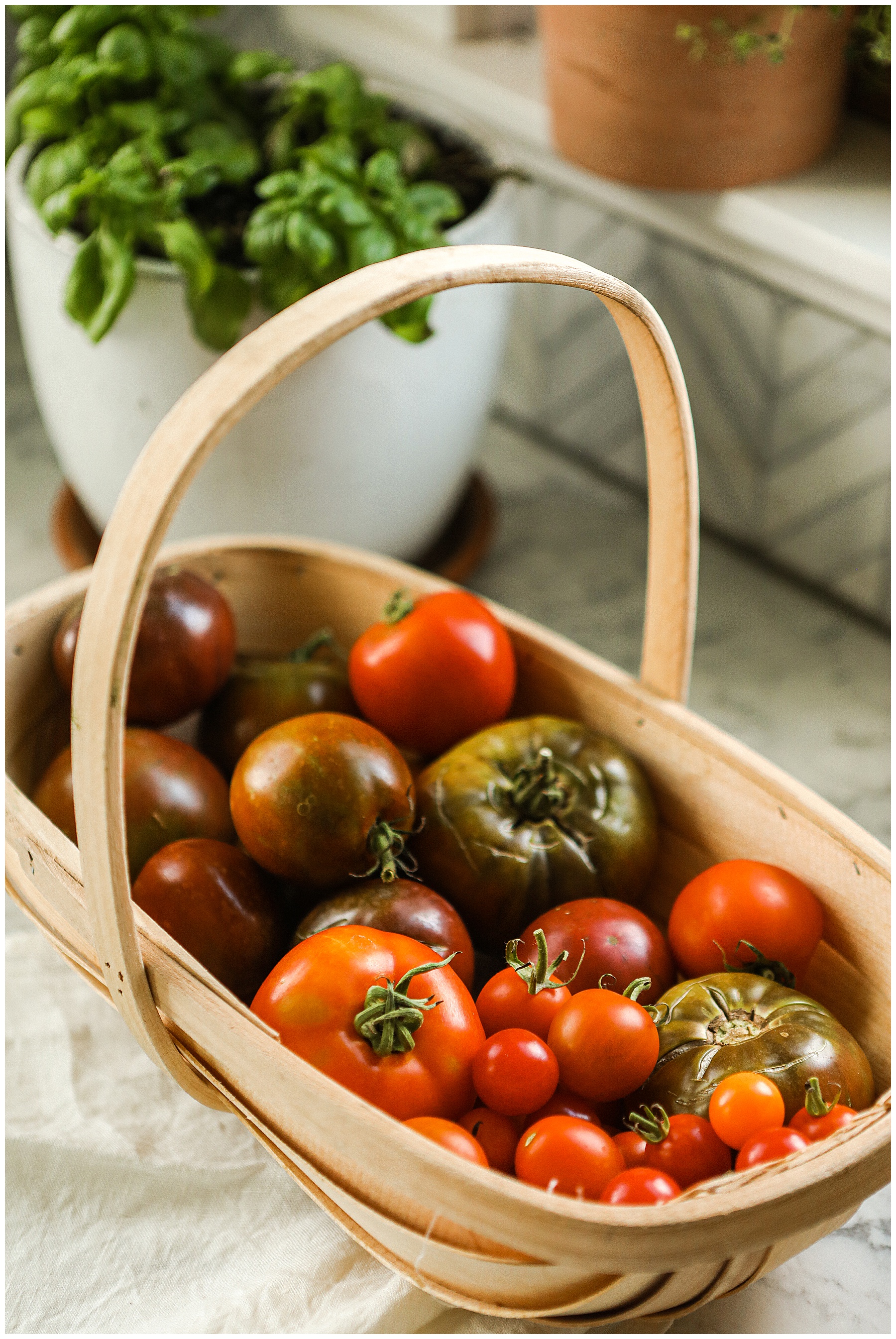
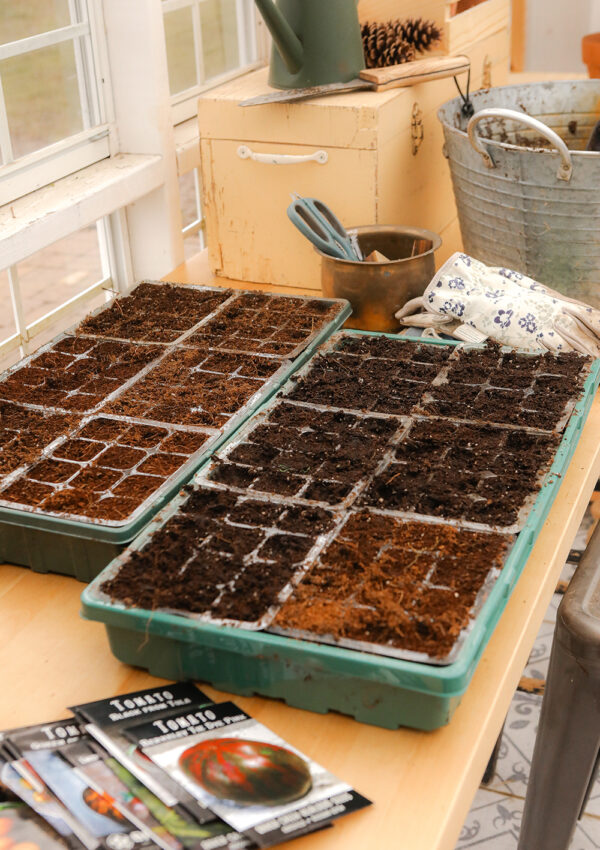
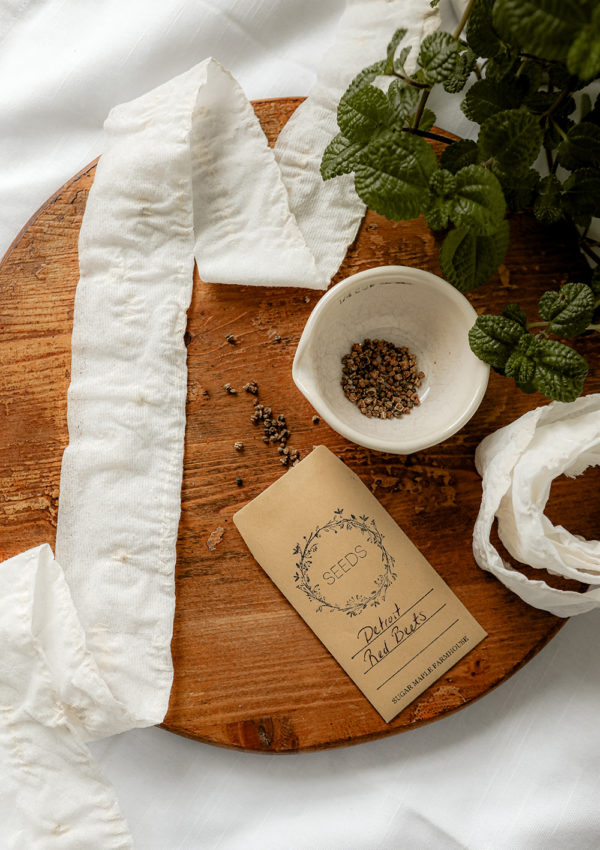
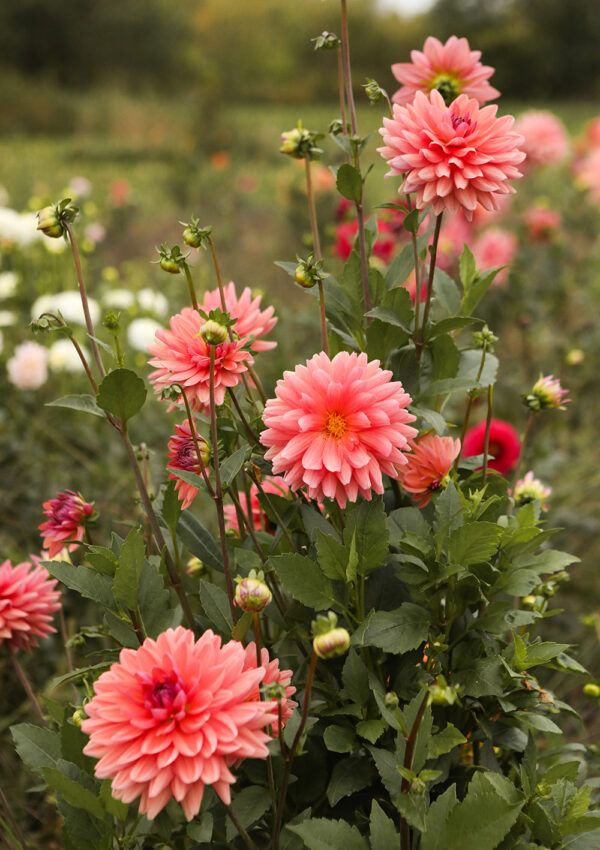



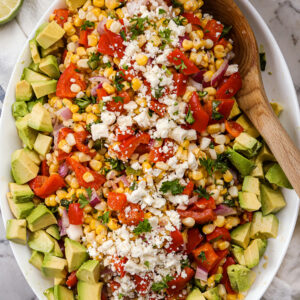

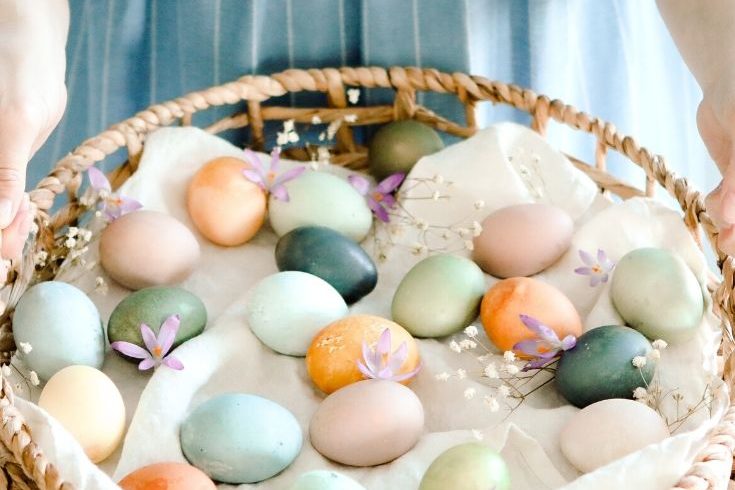

Yum, I just love tomatoes. I wish I had the patience to grow them but I do not. My mom does though! I’ll show her this post.
We planted a few different types of tomatoes this year and they have already sprouted like crazy!! Can’t wait to eat them. There is nothing better than fresh tomatoes.
I need to give this a try. I love having fresh fruit and veggies through gardens. I have a small garden this year. We always do tomatoes as well.
How I wish I can grow my own tomatoes! Having fresh tomatoes right at home is perfect!
These are such great tips, My tomatoes didn’t grow good last year at all
A beautiful list for tomato cultivation and growing. It has been really hard for me to grow anything veggies in South Florida, as all of my plants have been destroyed either by insects or birds or lizards.
I began testing big container gardening. And it goes much better.
I will use many of the tips for tomatoes this season on my plants. Thank you!
thanks for these great tips.. i hope we can water our tomatoes (plants we got, not from seeds) just enough… We didn’t get any other plants for our garden since it is super hot and dry (and another drought year) for us in California this year..
I wanted to start my tomatoes from scratch and these are such great tips! Following them now to get my garden started for the season.
I always wanted to grow tomatoes! These tips for growing tomatoes from seeds & through the season will definitely help me take off on this mission. Thanks.
Think in my next life, I will be a farmer. Love how fresh and juicy the tomatoes look.
I can’t wait to start plants fruits and veggies in our garden! Thanks for the tips!
These are great tomato growing tips!